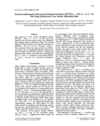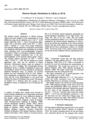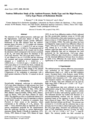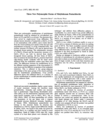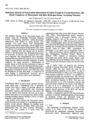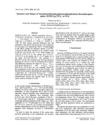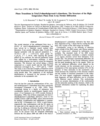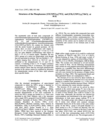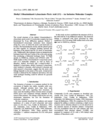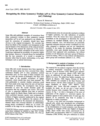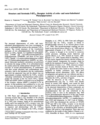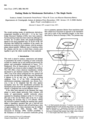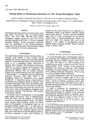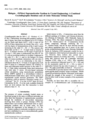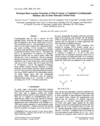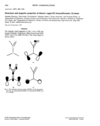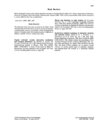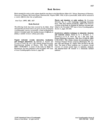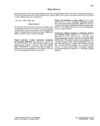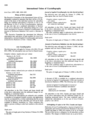issue contents
December 1997 issue

Cover illustration: Contoured distribution of hydrogen bonds from N-H and O-H donors about the oxygen acceptors of the disulfate dianion. Data for the 232 hydrogen bonds (O...H > 2.62 Å) were computed from the Cambridge Structural Database and the required symmetry was applied to generate the final distribution. Courtesy of M. Verdonk and J. Cole
research papers
The structure refinement of composite modulated Nb2Zrx-2O2x+1 (x = 8) has been carried out in superspace group Amma(α10)0s0. The equivalence of this present result to an earlier published refinement of the x = 12 member is established.
Download citation


Download citation


The structures of the layered intergrowth phases SbIIISbxVA1-xTiO6 (x≃0, A = Ta, Nb) have been refined by the Rietveld method, using synchrotron X-ray diffraction data. Starting models were proposed on the basis that the phases represented n = 1 in the series SbnIIISbxVAn-xTiO4n+2, for which the n = 3 structures (x = 1.26, A = Ta and x = 0.89, A = Nb) had been previously solved by single crystal X-ray diffraction. The models were found to be essentially correct.
Download citation


Download citation


The σ–π bonding is analysed using the Hansen–Coppens multipole model and compared with Hartree–Fock calculations. The amount of transfer of π electrons from the O atoms to the triangularly coordinated B atoms is specified.
Download citation


Download citation


Compression of the RuO6 octahedron is anisotropic. In the high-pressure phase the octahedra are rotated by 1.1° with respect to the ambient-pressure phase.
A new model is proposed to accommodate zero and some negative oxidation states of a central atom in the bond-valence sum formalism.
Download citation


Download citation


Three new polymorphic modifications of MoCl5 have been obtained as single crystals by solvothermal syntheses using CCl4 and SbCl5 as solvents. All structures consist of double octahedral Mo2Cl10 molecules and are derived from the closest packings of Cl atoms with different stacking sequences.
The bidentate function of the thiocyanate anion with respect to metals and/or hydrogen-donor groups was systematically studied using the Cambridge Structural Database.
Models of two-dimensional centrosymmetric and non- centrosymmetric structures have been generated and used to test genetic algorithms for direct phasing of surface diffraction data.
Download citation


Download citation


The crystal structure of [P(NPCl3)4]+PCl6−, determined at 93 K, and the thermal motion of the highly flexible cation, analysed in terms of the rigid-body model with allowances for intramolecular torsions, are reported.
Download citation


Download citation


The 164 K phase transition of ferrocene is not a simple order–disorder transition.
Download citation


Download citation


The effectiveness of the Patterson search method has been demonstrated by determining the crystal structure of the high-temperature phase of C16H22N6 from laboratory X-ray powder diffraction data. Phase transitions between two isomers of the title compound have been investigated.
CCDC reference: 131700
Download citation


Download citation


The results of conformational analysis of seven imidooxy derivatives and the molecular structures found in the crystal for five of them are reported and examined in relation to their activity as anticonvulsants.
Download citation


Download citation


The first crystal structures of compounds in which two NPCl3 groups are bonded to a single C atom are reported. The cations show the same cis–trans conformations of the backbone; the extremely flexible C-N-P angles can be attributed to intramolecular contacts.
Download citation


Download citation


The crystal structure of diethyl 2-benzimidazol-1-ylsuccinate–picric acid (1/1) has been determined by X-ray diffraction analysis. The benzimidazole moiety of the molecules forms channels along the a axis in which the picric acid molecules are located, forming an inclusion molecular complex.
CCDC reference: 131684
Recognizing the (False Symmetry) Triclinic (aP) to (True Symmetry) Centred Monoclinic (mC) Pathology
Examination of the published data for about fifty crystals where the originally reported triclinic unit cell has been corrected to centred monoclinic re-affirms the importance of calculating the Niggli matrix (metric tensor) as early as possible in a crystal structure analysis.
Download citation


Download citation


X-ray diffraction and molecular mechanics calculations are used to determine the 5-HT2C receptor activating conformation of phenylpiperazines. The conclusions are supported by preliminary biological studies on two novel 5-HT2C ligands.
Crystal packing modes of nitrobenzene derivatives are pre- sented. The different types of `single stack' modes are described in terms of geometrical parameters.
The `pseudo-herringbone' mode of packing for nitrobenzene derivatives is analysed. The mode is divided into four motifs, according to geometrical parameters.
Analysis of crystallographic data indicates that C-X⋯O(nitro) interactions increase in strength in the order Cl > Br > I, and that the frequency of formation of `bifurcated' motifs, involving X approach between the nitro-O atoms, increases in the same order. Intermolecular pertubation theory calculations on Cl⋯O and Br⋯O interactions agree with these geometrical observations and yield a Cl⋯O interaction energy of ca -6 kJ mol−1 at the 6-31G* basis set level.
Analysis of crystallographic data shows that nitro-O⋯H-N,O hydrogen bonds are significantly longer (weaker) than their counterparts that involve >C=O acceptors and prefer to form asymmetric motifs with respect to the nitro-O atoms. Intermolecular perturbation theory calculations agree with these experimental observations and indicate a hydrogen-bond energy of -15 kJ mol−1 at the 6-31G** basis set level.
short communications
Correction to Acta Cryst. (1997). B53, 673-679.
Correction to Acta Cryst. (1997). B53, 654-661.
books received
Free 

Free 

Free 

international union of crystallography
Free 



 journal menu
journal menu












